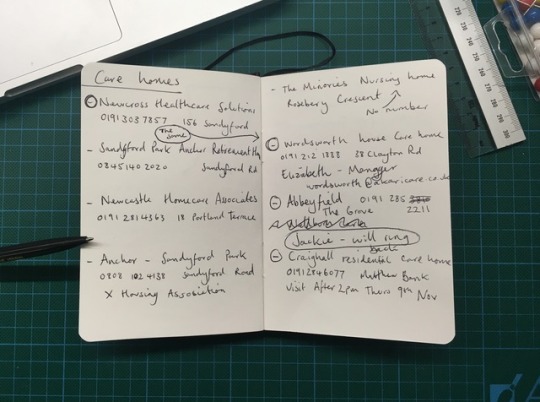Photo

A group of us are designing a form of chair for our final project, we designed an ergonomics testing chair rig and filled out a material requisition form; now we are just waiting for the material before we start building (22/11)
0 notes
Photo

Conducted an interview with Samantha Roberts, a radiotherapist at Warrington NHS who has worked closely with nurses and patients on wards for several years. This meeting was intended to find out how commodes are used within a hospital, and the problems noticed by staff members when patients are using one.
Commodes used in wards are often shared between many rooms, so bedpans are sometimes used as an alternative when it is too difficult to get the patient on, or the shared commodes are in use. In a ward, it is very obvious when one is in use as the curtains get drawn, the sounds are all audible and the smell afterwards lingers. Could there be a way to prevent the noise with choice of material? Can foul smells be prevented by releasing a pleasant fragrance upon impact? Urinating down onto a hard plastic disposal bowl causes splash-back; this material is easy to clean but does not seem like the correct choice.
I was also informed that on some short staffed wards, patients can be left stranded on commodes after use as they are unable to get off on their own and are left sat over their own faecal matter for extended amounts of time. If the height could be adjustable to reach the same height as their bed and the support arms folded down, could the user get on by themselves? If the user could use this alone, it means the patient could possibly return home instead of taking up valuable bed space.
Commodes are sometimes used as wheelchairs to transport patients around the hospital.
These bedside toilets are used with people recovering from knee and hip operations; the biggest problem they face with them is the height, bending down to sit is a consistent struggle where extra help is needed. Solutions to this could be to make a height changeable commode which can be adjusted by the user from their bed, or even take inspiration from raised toilet seats and have individual seats that clip on to elevate the chair to the required height.
When patient is discharged from hospital they are given a commode if needed; these are not accepted back from the hospital for sterilisation, even if never used. Could it be possible to create a modular commode, where certain parts like the frame can be sent back to be sterilised and re-used? Whilst all of the parts that have been in contact with faecal matter can be binned. Infection prevention is key, but is there any way to keep waste down?
As populations are getting larger, they are also getting heavier, this product needs to be able to support people in bariatric wards. Is there anything similar in the USA to take inspiration from?
All of this information opens up many questions, now I need to conduct tests to find answers. (11/11)
0 notes
Photo

Purchased a “best selling”, foldable commode from the main supplier to the NHS. With this I aim to look into the material properties, ease of use and run several tests to see how the product could be improved. I intend to also disassemble the product after testing and break it into individual components, interrogating what works and its value to different users. (21/11)
0 notes
Photo

Created two short questionnaires to find out the problems with using a commode at home. One was aimed at the user, and one was aimed at the carer. I then posted these to several relative Facebook groups. (15/11)
0 notes
Photo

Visited Craghall Residential Care Home and interviewed Becky, a carer This was a useful visit, but not necessarily what I wanted to hear. I found that most Care Homes are now purpose built facilities with en suites which have big enough rooms to leave a commode out permanently if necessary. Most residents were in the late stages of dementia, and therefore were simply not phased by having to use a commode. Also, the carers at this Home suggested that the emptying and cleaning of these was not a major issue for them; in her words “this is the job we signed up for”. However, Becky did note a few difficulties the resident had with getting on to the commode, noting stability and height. Stability so they can be confident when placing their weight on the commode, and the height was a major issue for residents with bad knees and hips (of which there were a lot). So, if the carers and residents are not necessarily the main issue, what about the families coming to visit their relatives? How can I prevent the embarrassment of them seeing/smelling faeces or the sight of an ugly commode? (9/11)
0 notes
Photo

Contacted the leading provider of clinical services to the NHS about the possibility of borrowing a range of commodes for research purposes. (8/11)
0 notes
Photo

Contacted local care homes and enquired about conducting interviews with staff members about their experiences and interactions with commodes. (8/11)
0 notes